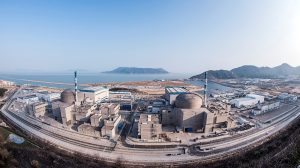On August 19, during a State Council meeting, Chinese Premier Li Qiang approved 11 nuclear reactors in the coastal provinces of Jiangsu, Shandong, Guangdong, Zhejiang, and Guangxi, with an estimated total investment of $33.3 billion. The development aligns with China’s broader green transition goals outlined in a recent guideline, which identified coastal nuclear power alongside wind, solar, and hydropower as central to decarbonizing energy-intensive industries and building clean energy bases.
As of July 2024, China’s nuclear energy operational capacity puts it just behind second-place France, but its ambitious plans for expansion position the country to potentially surpass both France and the United States (currently the top producer of nuclear energy) by 2030.
According to the Global Energy Monitor, China has 58.1 GW of operational nuclear capacity, to France’s 64.0 GW. However, the country has ranked above France in annual electricity generation from nuclear sources for four consecutive years. China has also been rapidly scaling up its nuclear capacity for the past decade, while France’s has remained largely stagnant since the beginning of the 21st century.
China’s nuclear power expansion is driven by its goals to meet increasing energy demand while reducing reliance on fossil fuels and achieving carbon neutrality by 2060. The 14th Five-Year Plan (2021-2025) aims to increase the country’s operational nuclear capacity to 70 GW by 2025. Although China may fall slightly short of this target, it is expected to overtake France’s 66 GW by 2026, securing its position as the country with the second-largest nuclear power capacity.
Although the United States currently leads all countries with 94 operational nuclear power units and a total capacity of 102 GW, China’s progress is likely to rapidly shrink the differential over the next decade. Its total prospective capacity – taking into account nuclear power plants that have begun construction – would see it surpass the United States.
During the early 2000s, the Chinese leadership astutely pivoted to support electric vehicles before EVs gained widespread popularity. Similarly, in the nuclear energy sector, China is now at the forefront of advancing and implementing cutting-edge technologies, especially Generation III and Generation IV reactors. It has not only adopted the AP1000, a Generation III reactor designed by U.S.-based Westinghouse, but has also developed its own Generation III reactor, the HPR1000 or Hualong One.
With four Hualong One units operational in China, 13 under construction, and international deployments in Pakistan and Argentina, China is establishing itself as a technological leader and supplier in the global nuclear power market.
Furthermore, China is at the forefront of advancing Generation IV reactor technology. In December 2023, the world’s first Generation IV nuclear unit, the HTR-PM (High-Temperature Reactor Pebble-bed Module), entered commercial operation in China. This small modular reactor (SMR) design showcases China’s commitment to flexible deployment and quicker construction of nuclear power plants.
Despite this impressive nuclear power expansion, the country has faced setbacks in its inland nuclear power development. Following the 2011 Fukushima nuclear accident in Japan, the Chinese government imposed a moratorium on the approval of inland nuclear power plants, citing concerns about safety and environmental impacts. As a result, China has canceled 185 inland nuclear units with a combined capacity of 201 GW, larger than the current operational U.S. reactor fleet.
The lifting of the inland nuclear moratorium has been a topic of discussion in light of China’s ambitious carbon reduction goals. Some canceled inland projects, such as the Taohuajiang, Xianning Dafan, and Jiangxi Pengze nuclear power plants, may have a smoother pathway toward eventual construction and operation due to their pre-construction preparations and initial investments.
As China continues its ambitious nuclear expansion plans, closely tracking the ratio of project cancelations to new additions will be crucial in assessing the overall success and sustainability of the country’s nuclear power strategy.
































